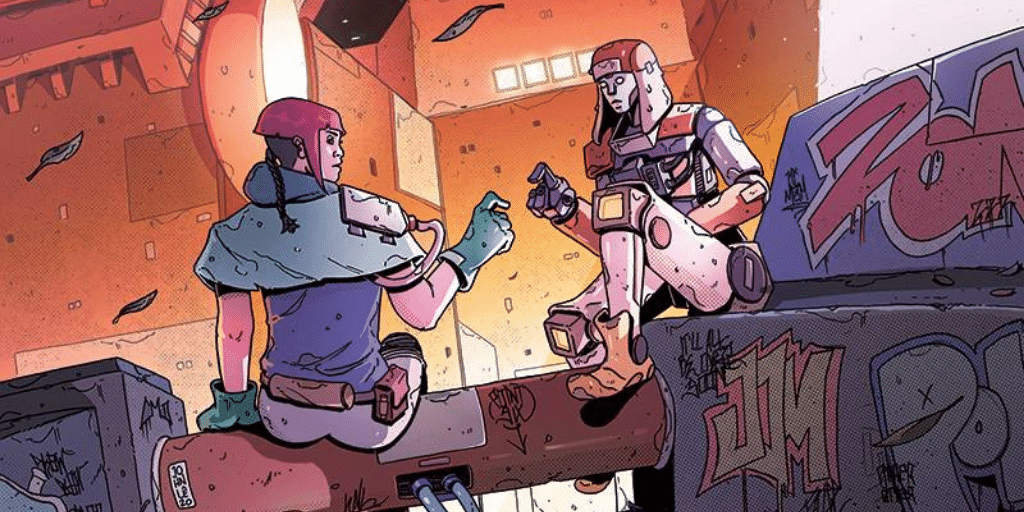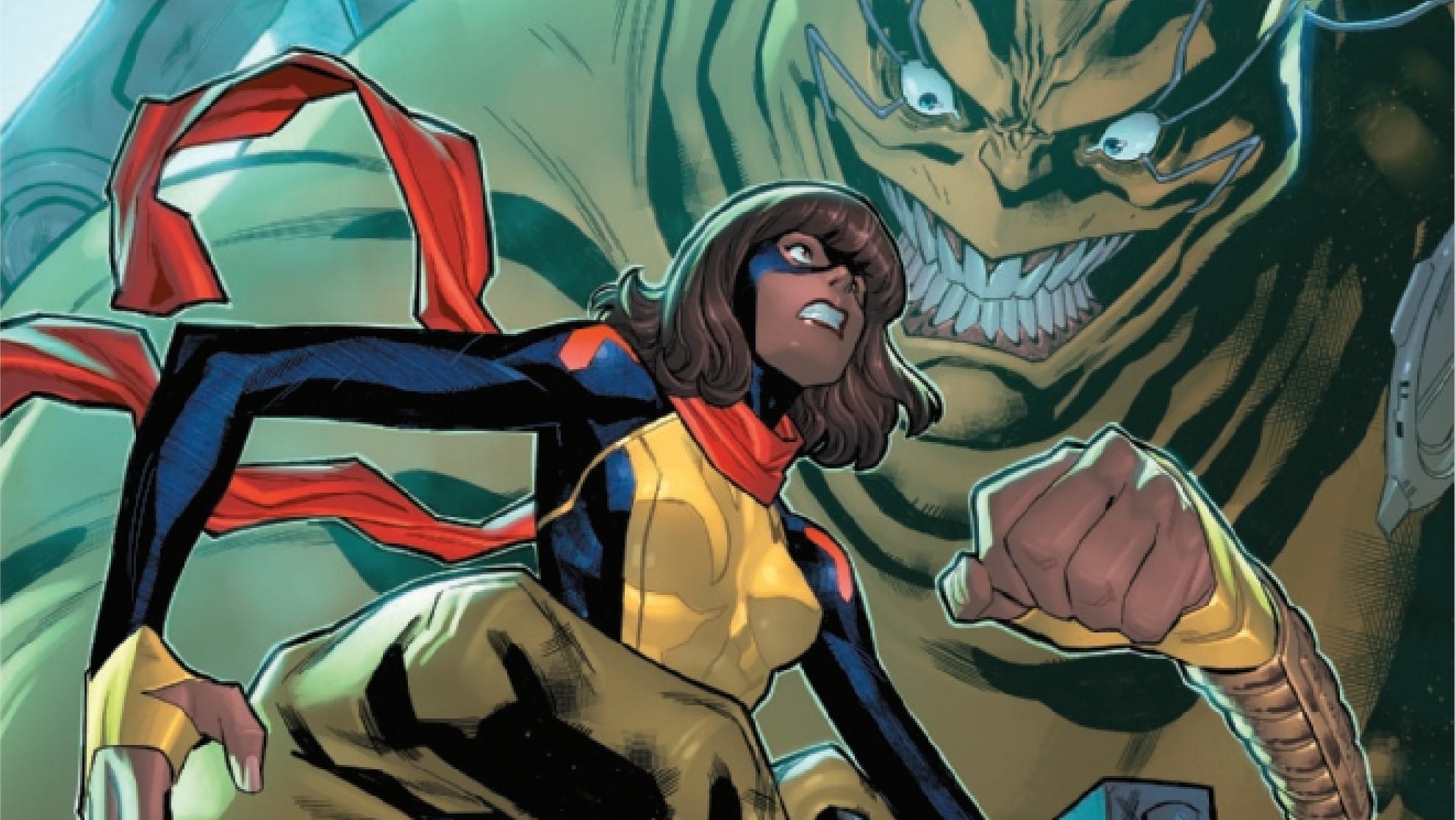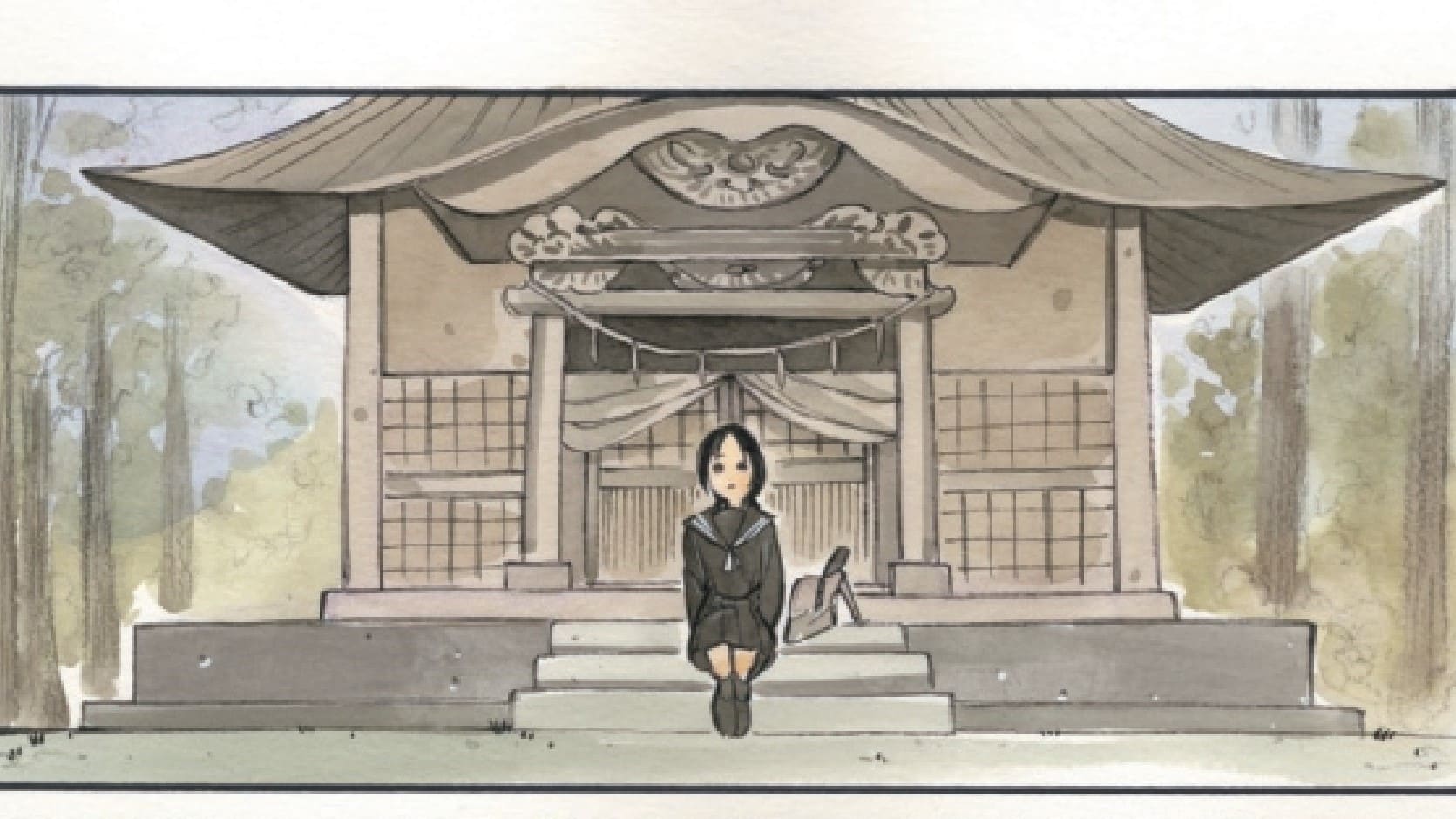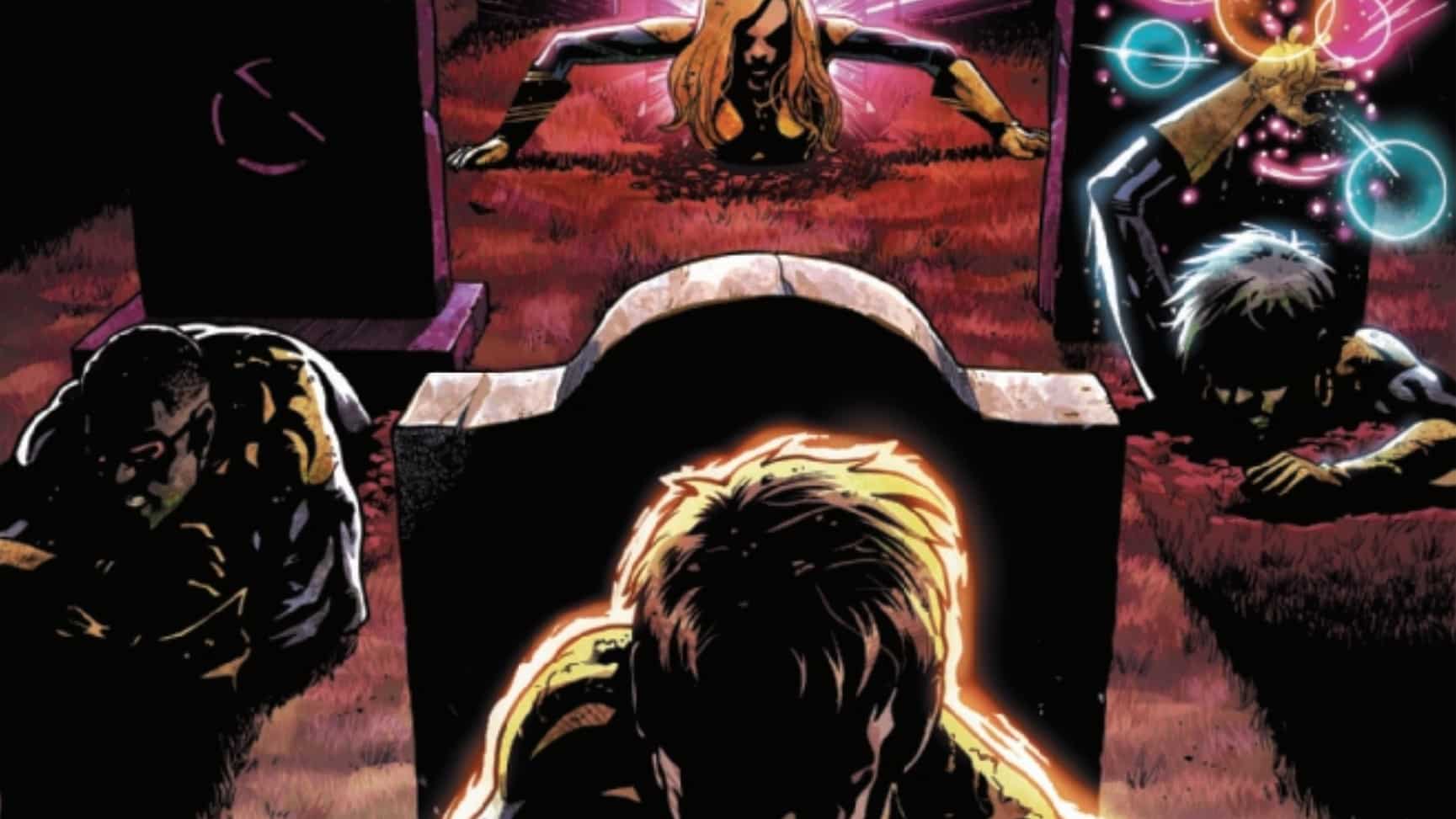Evan’s oldest friend returns to find the prosthetics she once built transformed into her doppelganger. Mason and the Order of The Red Relay investigate an elephant graveyard of towering Giga remains. Let’s return to the world of Giga with issue #3, written by Alex Paknadel, drawn by John Lê, colored by Rosh and lettered by Aditya Bidikar.
Zach Rabiroff: Welcome back, dear readers, to the loving gaze of our robot overlords. It’s the long-awaited return of Giga, and I’m excited to sink my teeth into issue #3. You ready, Ian?
Ian Gregory: It’s been a minute [Grote’s note: Damn near four months], but I’m so glad that Giga is back. Paknadel and Lê manage to cram so much into every issue that I’m always surprised it’s just a standard-length comic.
God Thoughts

ZR: When I was 6 or 7 years old, my parents, my brother and I took a day trip out to Long Beach to putter around the pier on a summer afternoon. There, underneath the shell of a geodesic dome, was housed the hulking frame of the Hughes H-4 Hercules, better known as the Spruce Goose: Howard Hughes’ 300,000-pound, $23 million boondoggle of an aircraft, which made exactly one test flight before being unceremoniously put out to pasture. Back then, at least, tourists were permitted to walk around at leisure inside the perfectly preserved interior, through the industrial weirdness of the massive fuselage, and into the flight deck. And standing there, looking at the rows upon rows of ancient computer systems and arcane dials, I remember thinking to myself, what would it have been like to be this plane? Not a pilot or an engineer, but the ineffable sum of the man-made circuitry itself, calculating its way through that first and only flight?
I never did find an answer to that question, but I couldn’t help but think back to it while reading this issue, which seems to circle elliptically but consistently around that very same notion: the gnawing, unachievable desire to know the mind of a towering machine. It’s a theme we glimpse right from our first scene, which begins, as every issue has so far, with a flashback to more innocent days for Evan and Aiko. This time, I think, we finally start to get some clarity on what it is that’s been driving Aiko all this time. She is, as we’ve seen before, an outsider to the high-born hereditary status into which Evan has been privileged to enter, and she was consequently much more willing to express an open skepticism of Red Relay dogma (“We wrote the Book of Assembly, Evan — people,” she chides her friend). But as she scales the heights of the city only to stop just short of the highest peaks of the Giga’s head, we sense a genuine poignancy to her words as she tells Evan, “This is where I come to think. Roof of the world. But this is as high as I go. I’m not like you. I’m low-born. I’ll never be allowed in the sacristy. I’ll never see a brain.”
And that desperate need to commune, mind to mind, with a being so utterly foreign and so unfathomably powerful, has been the quest that’s led Aiko to extremism, to disaster and to what must have been incredible loneliness in her quest. Even her creation of technology to allow Evan the use of prosthetic legs here turns out to be a baby step toward communication with the machine mind. Evan jokes about “touching the hem of the infinite,” but of course, that’s exactly the use to which we’ll discover his neural interface has been put later on in this issue — with devastating consequences for more than just Aiko herself. So while this sequence doesn’t exactly establish Aiko as a heroic lead in this story, it might make her a tragic figure nevertheless: Her actions are born out of a need to look mind to mind with the divine machine. And 6-year-old me can kind of see where she’s coming from.
IG: I guess I’ll tell a story about impressive aeronautical machinery, too. When I was in middle school, I went to Cape Canaveral – err, the Kennedy Space Center. They’ve got a neat museum there, and you can take a tour and see the buildings they assembled space shuttles and now other things in. In the museum, they keep talking about the Saturn V rocket, which they used for the Apollo program. After several rooms of seeing pictures of this thing, and reading about it, and so on, you finally walk into this massive hangar area and they have a Saturn V laying on its side. Each individual thruster is something like 12 feet tall. The feeling that overcame me, looking at those giant thrusters pointing at us as we walked in, is that if they ignited right then everyone in that warehouse-sized room would be dead on the spot.
OK, mostly I was jealous of your story. But machinery of this size does inspire a kind of supernatural fear, in my opinion, like it’s completely out of our control. Evan’s autopsy of the Giga is a really great scene because of how it reinforces the scale of these machines. It does seem implausible that humanity cannot blow open a Giga with just some plastique, that the only thing operating on the scale of a Giga is a Giga (they’re peerless in that way). I also thought the “wasp in the ear” metaphor was particularly apt. Mankind are like bugs to Giga, or more specifically parasites. At the very least it suggests to us that humans weren’t meant to directly communicate with the Giga. Something in that interaction appears to inspire suicidal desperation from the Giga themselves.
ZR: The wasp analogy is about as literal an application as I can imagine of Shakespeare’s line about flies to wanton boys. Except this god didn’t kill for sport, but out of frustration, pain or a need to remove some foreign body poisoning its system. Back in issue #1, Evan opined that humans were the Giga’s “microbial helpers.” Here, however, they’ve acted as something akin to a bacterial infection. You can think of it as the most egregious possible dereliction of duty on the part of the worshippers who are supposed to be tending to these beings. Unless, of course, the killers aren’t worshippers in the first place — but more on that later.
What I do want to stress is that the issue underlines in any number of ways the (as you mention) absolutely vast difference in scale between humans and their robot overlords. There is, to begin with, the visual scope of both the autopsy scene — a really terrific two-page spread from John Lê, who uses the Giga’s heaping body to literally frame the human conversation — and the illuminated Giga cityscape in the earlier flashback. I hope I’m not beating a dead horse to mention again how impressed I am by Rosh’s coloring choices in this series, but this splash page is a great example of why, with its mostly flat palette of subdued colors illuminated under glowing rays of white and orange to create an image of the urban divine.
But the difference in scale comes through in the writing, too. Take, for example, the funny but surreal scene of the Red Relay officer getting his kinky kicks under the silent gaze of his god. Or, more poignantly, take Evan’s tortured soliloquy (there’s that King Lear parallel again) about the silence of the gods, greeted only by the clang of a falling metal beam. We are so far from the Giga that we can only conceive of them in terms of our own confusion, despair or bizarre fetishes. And who, standing so close to the very bodies of their god, wouldn’t want something more than that?
IG: I’m drawn back to thinking of Macross, particularly the first series from 1982. In that series, mankind builds a massive spaceship that transforms into a humanoid mech. Forced to flee Earth, an entire city of people live within the Macross for the vast majority of the show. Macross is, primarily, a romance show, where our main characters date and argue and sing Japanese pop songs all while intermittently deploying in fighter jet mechs to fight off alien invaders. These romantic relationships happen within the belly of the Macross. When it transforms, the entire interior structure of the Macross changes: sometimes it crushes buildings, or people, and in one episode, the transformation traps our male and female protagonists together where they grow closer. The romantic relationships of the show essentially happen at the whim of this giant mechanical city-cum-death machine that humanity has cobbled together.
Everything happens in Giga in the eyes of the Gods, as our Red Relay officer says. As indifferent as they are to humanity, everything revolves around them. It generates not just a physical helplessness (as the falling panel that nearly crushes Evan demonstrates) but a social one. City-based society in Giga happens only at the say-so of these absent, aloof machine gods. Reviving these gods, and making contact with them, not only enables a political revolution against the church, but upends the entire social order. How will a culture whose entire social system and methods of interaction depend on the existence of Giga react if that were to change? Like in Macross, the Giga aren’t just tools or weapons, they are a livelihood, a physical representation of an entire society. Mecha shows often focus heavily on the use of these machines to disrupt society, but typically only through force (in Gundam 00, for example, our protagonists seek to end war by … threatening to destroy every country that engages in war. It is, to say the least, hypocritical). Here, the mechs are the society. It’s a nonviolent exploration of how these massive machines can affect society, with due appreciation paid toward their scale, literal and societal.
Homicides and Deicides

ZR: Beyond the heady theology of robot heads, this issue is really a murder mystery — or, rather, two murder mysteries that may really be one. There’s the strange death of the wild Giga that we saw last issue for which Evan provides the cause of death here: the same neural interface that created the gruesome scene at the start of this series’ first instalment. That pretty definitively positions Aiko as our (probably accidental) culprit here, even as it casts Evan himself into some serious legal jeopardy. More mysterious by far is the murder of Mason’s colleague Saber, whom we find dead with a terrified expression frozen in place. Given that Saber, it’s now clear, was involved in a coverup around the Giga’s death, this strongly hints at a conspiracy at work. But how far does it reach, and to whom? Ian, who’s your likely suspect here?
IG: I have several thoughts on this, though to begin with I like these paralleled, multi-scale murder mysteries just as a concept. Saber’s death denies Mason any easy answers about what’s going on and keeps him as a character whose moral choices are in balance: Will he stay firmly on the side of the church, or will what he discover push him away? Saber’s death feels perfectly timed and calculated, and it’s also hard to decide who would benefit other than the church. It definitely doesn’t help that the church is happily fomenting war with the Dusters, a war built on Saber’s testimony. But it does make me wonder why Saber decided to lie in the first place: Was he coached ahead of time to simply pin it on the Dusters, no matter what? Did he report his observations to the church before being killed?
On the subject of the Giga’s murder, however, everything seems to point toward Aiko. But if my mystery knowledge tells me anything, it’s that she’s far too obvious to be the true culprit. What do you think?
ZR: Saber’s participation in the coverup is definitely the biggest outstanding question mark at this point. It would seem pretty plausible if, hypothetically, he had worked for the church to conceal the truth behind the Giga’s death, only to find himself bumped off to permanently ensure his silence — not to mention pin the murder on more politically advantageous groups.
All of which is to say I suspect Aiko could well be a red herring, not only in the death of the Giga, but in the murder of Saber. In the later case, the comic is structured to at least give the impression that she has an alibi at the time of death: breaking into Evan’s apartment, where we find her having repaired Laurel in the series’ cliffhanger ending. I’m very interested to see how this reunion is going to play out, and whether the two estranged friends and their robot companion are going to form an odd little love/hate triangle together. Evan clearly takes a kind of comfort in being Laurel’s protector, and while Aiko has come to the rescue here, I wouldn’t be surprised to see more than a twinge of jealousy if she’s swooping in to take his place. Any thoughts on how you see this playing out, Ian?
IG: I think we’ll see a war between Evan’s natural curiosity and drive to change things, and his need for self-preservation. Before the events of this series, he could have both: hiding out of sight of the church and slowly working on building and improving Laurel. Now, both of those desires are threatened. Will he see Aiko as someone who can help him crack the secret of AI, both that of Laurel and of the Gigas, or as someone who will destroy everything he’s worked toward? We know the two were close in the past, maybe even romantically, but that’s a kind of chaos that Evan doesn’t need right now. That said — the back cover indicates that Laurel is “the prosthetics [Aiko] once built transformed into her doppleganger.” I hadn’t noticed until I took another look at this cover, but there is a definite aesthetic similarity between Laurel’s head and Aiko’s hair. Maybe there is a deeper longing in their relationship, one that could drive Evan to act recklessly?
I get the feeling that Giga is coming close to a breaking point, and that’s centered on how well Evan can balance the people in his life. What Aiko wants, what Laurel needs and what Mason knows are all in conflict with each other. The personal relationships in this story have a great tension and energy to them because we can see how Evan’s priorities tip and turn based on who he’s talking to. My guess is that in two issues we’ll have a big, “everything happens at once” moment where all these characters orbiting Evan’s life come into contact in a really spectacular way. The hard part is getting everything into place so that when things do fall apart it doesn’t feel cruel or unearned.
Mobile Suit Zeta Tolstoy

ZR: Beyond the philosophy and the murder plot, we also check in with the political dimensions of our story, beginning with a chilling sequence of a suicide bomber near a government center. Paknadel does a bravura job building up to the bomber’s attack, as his preaching — deliberately reminiscent of an Old Testament prophet — is juxtaposed with excerpts from the Book of Assembly telling of the origins of the Dusters. Granted, that structure risks (as we’ve mentioned here before) creating a kind of moral equation between oppressors and oppressed, but I’d argue that here, at least, Paknadel avoids the trap. That’s because we are never allowed for a moment to forget the disparity in power that exists between the Red Relay and the Dusters. Indeed, the attack is immediately used to justify a series of draconian and repressive measures cracking down on supposed Duster sympathizers: a move depicted (again with great verbal and visual flourish) in a cinematic montage of panels showing the authorities exercising their power over those below.
I love that we’re getting these glimpses at the power structures looming over the story, even as the heart of the drama remains with our little trinity of protagonists. For such a tight-knit story, Paknadel has been zooming out to an impressively wide scope, a move that makes the smaller-scale drama even more meaningful and powerful by its contrast. Probably because we’re dealing with a murder mystery here, it evokes most immediately HBO’s The Wire, another drama that used the inciting incident of a killing to open up progressively bigger windows onto the workings of an entire society. But with this story’s look at the uppermost government authorities, I’m reminded of perhaps my very favorite work of fiction, Tolstoy’s War and Peace, which took a cast of characters stretching from lowly peasants to the Emperor of France and used them to tell a story about the nature of history and mankind’s relationship to God.
Is comparing this comic book about big robots to Tolstoy too pretentious a move to end on? Well, probably. But it illustrates why this series impresses me more with each issue, and why I think Paknadel has managed to create an imaginative world rich and compelling enough to fuel many stories beyond this initial arc or these present characters. Giga, in other words, continues to delight.
IG: For you, War and Peace. For me, Mobile Suit Zeta Gundam. I’d say they’re roughly equivalent.
Giga is doing something very similar to Zeta Gundam in its treatment of politics. Zeta Gundam (the second Gundam show, released in 1985, and also in my opinion the best Gundam) details a struggle between our protagonists, members of what is essentially a terrorist organization, and an authoritarian military police. The personal struggle of our protagonist dominates the first part of the narrative, but as the story progresses, the scope expands, revealing all the ways that the personal conflict feeds into (and out of) a wider political context. Gundam loves its political speeches, especially speeches set to montages of violence. It’s an obvious tool, but one that does a good job of tying the more abstract moves of politicians to the oppression of regular people. It’s hard not to look at the Giga projecting the church’s speech and think of Garma Zabi’s funeral from First Gundam, for example.
Giga should be a complete mess of a book, in my opinion. It’s dealing with religion, political dissidents, murder mysteries and giant robots, all at once in the length of a regular comic book. I think it’s a testament both to Paknadel’s writing and Lê’s breezy visual storytelling that this book feels cohesive and incredibly smart.







